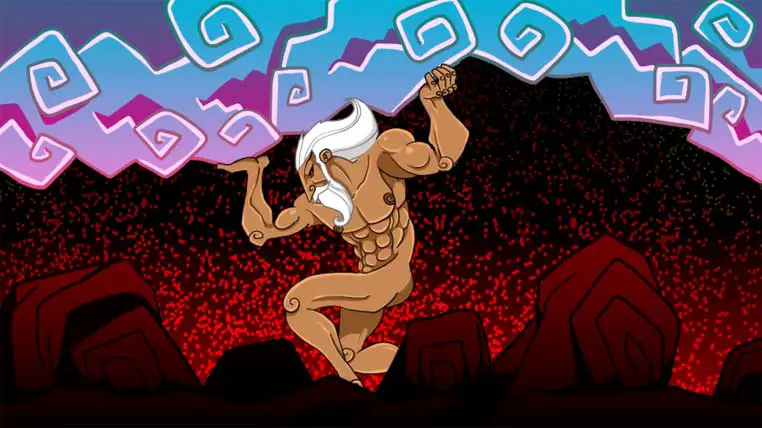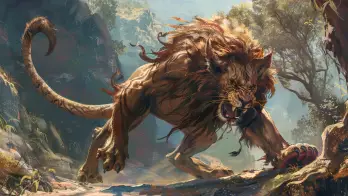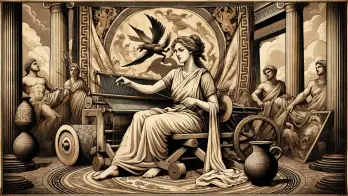The Chinese myth of creation is one of Chinese mythology’s most beautiful and fascinating legends.
These legends of Chinese mythology portray an ideal society to which the first people aspired, extol the virtues of steadfast and loyal love, celebrate nature, and contemplate the horrors of war in great depth.
The tales embody intense emotions, vivid imagination, tender praises, and genuine aspirations. Understanding these stories provides a glimpse into Chinese civilization.
People all over the world have their own legends about the origin of the world, through which they attempt to answer questions about how the sky, the earth, and humanity came into being.
These legends are diverse, yet they share certain similarities, which suggest that our ancestors had similar beliefs and ideas, even if they lived in an era of primitiveness and ignorance, with limited communication.
The Chinese Myth of Creation
The Chinese myth of creation is an exquisite and intricate fable that has been orally passed down for generations.
It portrays the creation of the universe and the origin of humans. The myth suggests that in the beginning, anarchy prevailed until two mighty forces, Yin and Yang, emerged from the chaos.
These forces embody opposing yet harmonious principles in the universe, such as light and dark, hot and cold, and masculine and feminine.
The story continues, revealing how Yin and Yang intertwine to form the universe and everything in it.
This encompasses the creation of the first humans, crafted by the goddess Nüwa from clay. Nüwa is a crucial figure in Chinese mythology, recognized as the creator of humanity and a symbol of female authority.
Contrasting with other mythologies, the Chinese myth of creation emphasizes balance and harmony.
Yin and Yang represent the concept of duality, a fundamental principle in Chinese philosophy, which is evident in all facets of Chinese culture, from traditional medicine to architectural design.
In contrast, other mythologies commonly depict a conflict between good and evil or a battle between gods and demons.
Greek mythology is an example, with the gods battling the Titans, while Hindu mythology depicts the gods battling the demons.
These myths share some similarities with the Chinese myth of creation, but emphasize conflict and struggle more.
Another unique feature of Chinese mythology is the Five Elements concept.
These elements, including wood, fire, earth, metal, and water, symbolize various aspects of nature and the universe.
Each element is linked to a specific color, direction, season, and emotion. This idea is utilized in traditional Chinese medicine, astrology, and even martial arts.
Conversely, other mythologies often concentrate on the gods and their connection to humans.
In Norse mythology, the gods resided in Asgard and interacted with humans on earth.
Similarly, in Egyptian mythology, the gods governed the afterlife and were believed to directly impact human lives.
Despite these differences, similarities exist between Chinese mythology and other mythologies.
For instance, numerous cultures recount tales of a flood that destroyed the world and a hero who rescued humanity.
In Chinese mythology, this hero is known as Yu the Great, credited with regulating the floodwaters and establishing the first dynasties.
The Pan Gu Myth
Once upon a time, a small bubble of air appeared out of nowhere when the universe was nothing but a vast emptiness.
Gradually, this bubble grew larger and larger until it transformed into a cloud, which then condensed into a ball. This ball continued to grow for countless years until it became a colossal red egg.
And from this egg, a miraculous creature emerged.
His name was Pan Gu, and he had spent 18,000 years sleeping inside the egg, waiting for his time to come.
According to Chinese mythology, the number nine symbolizes greatness. Pan Gu’s emergence from the egg after 18,000 years held immense significance as it was believed to be an incredibly long time.
As soon as Pan Gu woke up, he started to strike, struggle and break free from the chaos surrounding him. With every hit, the universe expanded slightly more, and eventually, the sky and the earth were born.
Creating the sky and the earth was no easy feat, but Pan Gu’s perseverance paid off.
A bright and transparent Yang Qi rose and formed the clear blue sky, while at the same time, a heavy Yin Qi descended slowly and gave shape to the earth.
The concept of Yin and Yang has always been a characteristic feature of Chinese culture and played a significant role in bringing harmony to the universe.
As Pan Gu grew taller, he found that the distance between the sky and the earth was not enough for him to stretch his arms and legs.
So, Nu Wa, a goddess, intervened and held up the sky with her hands and dug her feet into the ground to keep the sky and the earth apart.
The sky rose nine feet each day, and the earth moved away at an equal distance.
Pan Gu grew ten feet taller every day, and after another 18,000 years, he had become a giant of 90,000 li (45,000 km) in height, which was the exact distance between the sky and the earth, hence the name “Nine-Layered Heaven.”
Pan Gu’s influence over the universe was profound.
If he was happy, the sky was clear, and the air was cool. If he was angry, the sky would turn dark. If he sighed, fierce winds would arise. If he cried, his tears would turn into a raging storm. If he blinked, lightning would streak across the sky. If he snored, his snores would turn into thunder.
After living a lonely life between the sky and the earth for countless years, Pan Gu eventually passed away, causing a great crash.
His body transformed into various natural wonders like mountains, rivers, and forests.
Today, it is said that the sky is Pan Gu’s body, and the earth is his flesh and bones.
This legendary tale holds a special place in the hearts of the Chinese people, as it represents their love for their homeland and the powerful connection between the universe and all living beings.
Nu Wa Creates the First Humans from Clay
In ancient Chinese mythology, the creation of humanity is attributed to the goddess Nu Wa.
She emerged from the earth, a direct descendant of Pan Gu, the creator of the sky and earth.
Nu Wa is often portrayed as a kindly grandmother who wanted to fill the world with living beings and end the loneliness that pervaded it.
Nu Wa kneaded clay into figurines and placed them on the ground to achieve this. To her delight, the clay figures came to life as soon as they touched the earth.
They moved and spoke, sang, and laughed.
The clay figures surrounded Nu Wa and called her “Mother!” She was so happy that she continued to create more figurines day and night until she was exhausted.
At this point, Nu Wa decided to take a break and stuck a branch into the mud.
As she moved it around, droplets of mud fell and transformed into human beings. They climbed mountains, explored valleys, and populated the world.
Nu Wa divided them into men and women, and they paired up, gave birth to children, and became the ancestors of countless descendants.
In Chinese mythology, simplicity is a hallmark of creation stories, and this is closely related to the lifestyle of the ancient Chinese, who valued harmony and balance.
The idea of “patching the sky” exemplifies this philosophy. One could alleviate disasters and maintain a united and harmonious society by patching the sky.
According to Chinese mythology, the sky was supported by four pillars, and the earth was held up by ropes.
Over time, the pillars began to rot, and the earth cracked. Fragrant waters and powerful fires emerged from the cracks, and violent rains, hail, and meteors fell from the sky.
A Fierce Battle in the Heavens
In a single revolution of the earth around the sun, a great war erupted in the celestial realm between the omnipotent God of Fire, Zhurong, and the indomitable God of Water, Gong Gong.
Gong Gong was vanquished and fled for his life to the very edge of the heavens with Zhurong hot on his heels.
Alas, in his frantic escape, Gong Gong collided with Mount Buzhoushan, one of the four imposing pillars that held up the vast firmament of the sky, causing it to shatter.
The cataclysmic impact of the collision dislodged the sky and precipitated it to shift northwestward, while the earth sagged southeastward.
The shock waves reverberated across the entire universe, tearing open a colossal rift in the northwest of the sky and causing an uninterrupted cascade of water to pour out onto the earth below.
The resultant tremors shook the world and triggered devastating floods and wildfires, which spread uncontrollably, ravaging everything in their path.
As if this weren’t enough, the ancient and ferocious black dragon, once bound within the confines of the swamp in the Central Plains, sensed the chaos and destruction and broke free from its prison, unleashing further misery and suffering upon the hapless people.
Nu Wa, the benevolent mother of all humankind, was deeply distressed at the sight of her beloved progeny and the once harmonious world, now plunged into utter chaos and devastation.
Driven by her deep love and compassion, she embarked on a perilous quest, scouring every corner of the earth, collecting colorful stones of red, yellow, blue, white, and black, along with wood, to fuel her fire.
She tirelessly kindled a mighty fire for seven days and seven nights, melting the stones until they were liquefied.
Using the resulting liquid stones, Nu Wa painstakingly repaired the shattered firmament of the sky.
Then, with her unwavering resolve and fortitude, she sought out a gargantuan turtle from the depths of the ocean, and with her sharp blade, severed its legs and used them to replace the shattered pillars of the broken sky.
She then courageously vanquished the fearsome black dragon and drove all the wild beasts back into their natural habitats.
Finally, she spread the remaining ash from the liquefied stones over the flooded lands, transforming them into verdant and fertile fields.
Thus, the world between the heavens and the earth was restored to its former splendor and grandeur, except for the sky in the northwest and the land in the southeast, which remained slightly lower than before the calamity.
As a result, the sun, moon, and stars always set in the west, and the rivers inexorably flowed toward the southeast.
This mythical tale is a powerful reminder of a catastrophic event that plunged the world into despair and suffering.
Nu Wa, the great mother of all mankind, through her boundless ingenuity, compassion, and determination, showed her unending love for her children by striving to restore order and balance to the universe.
This fable underscores the importance of harmony and balance in our world and every individual’s indispensable role in fostering peace and stability.
At Ancient Theory we only use trusted sources to document our articles. Such relevant sources include authentic documents, newspaper and magazine articles, established authors, or reputable websites.
- Chinese creation myths. wikipedia.org. [Source]
- Birrell, Anne - Chinese Mythology: An Introduction. Baltimore: Johns Hopkins University Press, 1993.
- John S. Major - Myth, Cosmogony, and the Origins of Chinese Science. Journal of Chinese Philosophy, 1978.
- Pan Gu. britannica.com. [Source]
- Pangu. wikipedia.org. [Source]
- N. J. Girardot - The Problem of Creation Mythology in the Study of Chinese Religion. The University of Chicago Press, 1976.






